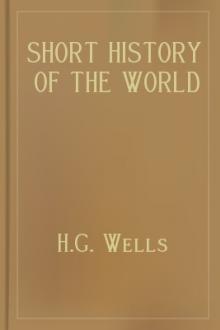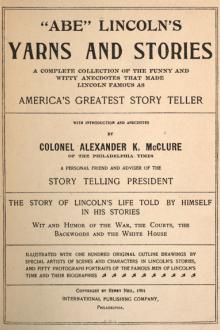A Short History of the World, H. G. Wells [beach books .TXT] 📗

- Author: H. G. Wells
- Performer: -
Book online «A Short History of the World, H. G. Wells [beach books .TXT] 📗». Author H. G. Wells
The accounts of the Creation of the World, of Adam and Eve and of the Flood, with which the Bible begins, run closely parallel with similar Babylonian legends; they seem to have been part of the common beliefs of all the Semitic peoples. So too the stories of Moses and of Samson have Sumerian and Babylonian parallels. But with the story of Abraham and onward begins something more special to the Jewish race.
Abraham may have lived as early as the days of Hammurabi in Babylon. He was a patriarchal Semitic nomad. To the book of Genesis the reader must go for the story of his wanderings and for the stories of his sons and grandchildren and how they became captive in the Land of Egypt. He travelled through Canaan, and the God of Abraham, says the Bible story, promised this smiling land of prosperous cities to him and to his children.
And after a long sojourn in Egypt and after fifty years of wandering in the wilderness under the leadership of Moses, the children of Abraham, grown now to a host of twelve tribes, invaded the land of Canaan from the Arabian deserts to the East. They may have done this somewhen between 1600 B.C. and 1300 B.C.; there are no Egyptian records of Moses nor of Canaan at this time to help out the story. But at any rate they did not succeed in conquering any more than the hilly backgrounds of the promised land. The coast was now in the hands, not of the Canaanites but of newcomers, those Ægean peoples, the Philistines; and their cities, Gaza, Gath, Ashdod, Ascalon and Joppa successfully withstood the Hebrew attack. For many generations the children of Abraham remained an obscure people of the hilly back country engaged in incessant bickerings with the Philistines and with the kindred tribes about them, the Moabites, the Midianites and so forth. The reader will find in the book of Judges a record of their struggles and disasters during this period. For very largely it is a record of disasters and failures frankly told.
For most of this period the Hebrews were ruled, so far as there was any rule among them, by priestly judges selected by the elders of the people, but at last somewhen towards 1000 B.C. they chose themselves a king, Saul, to lead them in battle. But Saul’s leading was no great improvement upon the leading of the Judges; he perished under the hail of Philistine arrows at the battle of Mount Gilboa, his armour went into the temple of the Philistine Venus, and his body was nailed to the walls of Beth-shan.
Beneath which are the remains of a great palace of Nebuchadnezzar
Photo: Underwood & Underwood
His successor David was more successful and more politic. With David dawned the only period of prosperity the Hebrew peoples were ever to know. It was based on a close alliance with the Phœnician city of Tyre, whose King Hiram seems to have been a man of very great intelligence and enterprise. He wished to secure a trade route to the Red Sea through the Hebrew hill country. Normally Phœnician trade went to the Red Sea by Egypt, but Egypt was in a state of profound disorder at this time; there may have been other obstructions to Phœnician trade along this line, and at any rate Hiram established the very closest relations both with David and with his son and successor Solomon. Under Hiram’s auspices the walls, palace and temple of Jerusalem arose, and in return Hiram built and launched his ships on the Red Sea. A very considerable trade passed northward and southward through Jerusalem. And Solomon achieved a prosperity and magnificence unprecedented in the experience of his people. He was even given a daughter of Pharaoh in marriage.
But it is well to keep the proportion of things in mind. At the climax of his glories Solomon was only a little subordinate king in a little city. His power was so transitory that within a few years of his death, Shishak the first Pharaoh of the twenty-second dynasty, had taken Jerusalem and looted most of its splendours. The account of Solomon’s magnificence given in the books of Kings and Chronicles is questioned by many critics. They say that it was added to and exaggerated by the patriotic pride of later writers. But the Bible account read carefully is not so overwhelming as it appears at the first reading. Solomon’s temple, if one works out the measurements, would go inside a small suburban church, and his fourteen hundred chariots cease to impress us when we learn from an Assyrian monument that his successor Ahab sent a contingent of two thousand to the Assyrian army. It is also plainly manifest from the Bible narrative that Solomon spent himself in display and overtaxed and overworked his people. At his death the northern part of his kingdom broke off from Jerusalem and became the independent kingdom of Israel. Jerusalem remained the capital city of Judah.
The bulls are in richly coloured enamel on baked brick
Photo: Underwood & Underwood
The prosperity of the Hebrew people was short-lived. Hiram died, and the help of Tyre ceased to strengthen Jerusalem. Egypt grew strong again. The history of the kings of Israel and the kings of Judah becomes a history of two little states ground between, first, Syria, then Assyria and then Babylon to the north and Egypt to the south. It is a tale of disasters and of deliverances that only delayed disaster. It is a tale of barbaric kings ruling a barbaric people. In 721 B.C. the kingdom of Israel was swept away into captivity by the Assyrians and its people utterly lost to history. Judah struggled on until in 604 B.C., as we have told, it shared the fate of Israel. There may be details open to criticism in the Bible story of Hebrew history from the days of the Judges onward, but on the whole it is evidently a true story which squares with all that has been learnt in the excavation of Egypt and Assyria and Babylon during the past century.
It was in Babylon that the Hebrew people got their history together and evolved their tradition. The people who came back to Jerusalem at the command of Cyrus were a very different people in spirit and knowledge from those who had gone into captivity. They had learnt civilization. In the development of their peculiar character a very great part was played by certain men, a new sort of men, the Prophets, to whom we must now direct our attention. These Prophets mark the appearance of new and remarkable forces in the steady development of human society.
THE fall of Assyria and Babylon were only the first of a series of disasters that were to happen to the Semitic peoples. In the seventh century B.C. it would have seemed as though the whole civilized world was to be dominated by Semitic rulers. They ruled the great Assyrian empire and they had conquered Egypt; Assyria, Babylon, Syria were all Semitic, speaking languages that were mutually intelligible. The trade of the world was in Semitic hands. Tyre, Sidon, the great mother cities of the Phœnician coast, had thrown out colonies that grew at last to even greater proportion in Spain, Sicily and Africa. Carthage, founded before 800 B.C., had risen to a population of more than a million. It was for a time the greatest city on earth. Its ships went to Britain and out into the Atlantic. They may have reached Madeira. We have already noted how Hiram co-operated with Solomon to build ships on the Red Sea for the Arabian and perhaps for the Indian trade. In the time of the Pharaoh Necho, a Phœnician expedition sailed completely round Africa.
At that time the Aryan peoples were still barbarians. Only the Greeks were reconstructing a new civilization of the ruins of the one they had destroyed, and the Medes were becoming “formidable,” as an Assyrian inscription calls them, in central Asia. In 800 B.C. no one could have prophesied that before the third century B.C. every trace of Semitic dominion would be wiped out by Aryan-speaking conquerors, and that everywhere the Semitic peoples would be subjects or tributaries or scattered altogether. Everywhere except in the northern deserts of Arabia, where the Bedouin adhered steadily to the nomadic way of life, the ancient way of life of the Semites before Sargon I and his Akkadians went down to conquer Sumeria. But the Arab Bedouin were never conquered by Aryan masters.
Now of all these civilized Semites who were beaten and overrun in these five eventful centuries one people only held together and clung to its ancient traditions and that was this little people, the Jews, who were sent back to build their city of Jerusalem by Cyrus the Persian. And they were able to do this, because they had got together this literature of theirs, their Bible, in Babylon. It is not so much the Jews who made the Bible as the Bible which made the Jews. Running through this Bible were certain ideas, different from the ideas of the people about them, very stimulating and sustaining ideas, to which they were destined to cling through five and twenty centuries of hardship, adventure and oppression.
Foremost of these Jewish ideas was this, that their God was invisible and remote, an invisible God in a temple not made with hands, a Lord of Righteousness throughout the earth. All other peoples had national gods embodied in images that lived in temples. If the image was smashed and the temple razed, presently that god died out. But this was a new idea, this God of the Jews, in the heavens, high above priests and sacrifices. And this God of Abraham, the Jews believed, had chosen them to be his peculiar people, to restore Jerusalem and make it the capital of Righteousness in the World. They were a people exalted by their sense of a common destiny. This belief saturated them all when they returned to Jerusalem after the captivity in Babylon.
Is it any miracle that in their days of overthrow and subjugation many Babylonians and Syrians and so forth and later on many Phœnicians, speaking practically the same language and having endless customs, habits, tastes and traditions in common, should be attracted by this inspiring cult and should seek to share in its fellowship and its promise? After the fall of Tyre, Sidon, Carthage and the Spanish Phœnician cities, the Phœnicians suddenly vanish from history; and as suddenly we find, not simply in Jerusalem but in Spain, Africa, Egypt, Arabia, the East, wherever the Phœnicians had set their feet, communities of Jews. And they were all held together by the Bible and by the reading of the Bible. Jerusalem was from the first only their nominal capital; their real city was this book of books. This is a new sort of thing in history. It is something of which the seeds were sown long before, when the Sumerians and Egyptians began to turn their hieroglyphics into writing. The Jews were a new thing, a people without a king and presently without a temple (for as we shall tell Jerusalem itself was broken up in 70 A.D.), held together and consolidated out of heterogeneous elements by nothing but the power of the written word.
And this mental welding of the Jews was neither planned nor foreseen nor done by either priests or statesmen. Not only a new kind of community but a new kind of





Comments (0)